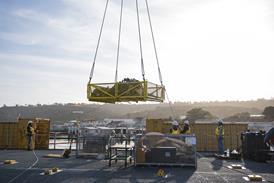
Tim Furniss/LONDON
Of all the advances in satellite communications since Telstar, the most interest is being created by the $9 billion Teledesic programme. Now that Teledesic has assembled a powerful industrial team to build and launch its 300-satellite constellation, the project is moving into high gear.
Teledesic's copyrighted "Internet in the Sky" motto is an apt description of a system intended, from day one of operations in 2003, to enable broadband telecommunications access for businesses, schools and individuals everywhere.
Formed in 1990 and backed initially by entrepreneur Craig McCaw and, on a personal basis, Microsoft chairman Bill Gates, Teledesic - based in Kikland, Washington - plans to create the first satellite network designed to provide affordable, worldwide access to digital services such as broadband Internet, video conferencing and high-quality voice communications.
MMS INVOLVEMENT
Matra Marconi Space (MMS) in Stevenage, UK, will produce almost 300 satellites for the system over the next four years. MMS' involvement came about as a result of the cancellation of Motorola's competing Celestri satellite service, for which the UK company was to be a major partner. Motorola joined Teledesic in May and took MMS with it, plus the technical effort already put into Celestri by the two companies. Boeing also joined Teledesic, to form one of the most powerful space liaisons in history.
"The globalisation of this effort has begun in earnest. The strengths of these companies and their reach are completely complementary. They have all performed on a world stage and now will bring the technical framework of Teledesic into focus," says McCaw, Teledesic's chairman and co-chief executive.
Motorola chief executive Christopher Galvin says: "This is a natural fit of core competencies, knowhow and vision. Rather than continuing along our separate paths, we're combining our best efforts to deliver a new generation of broadband communications services to people around the world."
Motorola will receive a 26% stake in Teledesic for a combination of cash and the value of design and development work that will be redirected from Celestri to the new joint effort. Motorola's investment totals $750 million.
Harry Stonecipher, Boeing president and chief executive, says: "We've been a longtime supporter of the Teledesic system and have worked with Motorola on the Iridium system. We think this joint effort makes a tremendous amount of sense." Boeing committed to a $100 million investment in Teledesic in April 1997, and is in prime position to be a leading launch services provider.
Prince Alwaleed Bin Talal Bin Abdul Aziz Alsaud of Saudi Arabia has invested $200 million in Teledesic through family trusts. The investment is "-subject to the parties entering into definitive agreements and obtaining necessary governmental approvals", Teledesic says.
Teledesic was licensed by the US Federal Communications Commission in March 1997 to build, launch and operate a global, broadband satellite communications network. The programme cleared its last significant regulatory hurdle in November 1997, when the International Telecommunication Union's World Radiocommunication Conference finalised its designation of an international frequency spectrum for use by non-geostationary fixed satellite services, such as those that Teledesic will provide.
The Teledesic constellation will operate in low earth orbit (LEO), eliminating the long signal delay normally experienced with geostationary satellite communications. The lower orbit also enables the use of small, low-power, terminals and antennas. The laptop-sized terminals will be mounted flat on a rooftop and connect to a personal computer or network.
The system is designed to support millions of simultaneous users, with access speeds more than 2,000 times faster than today's standard analogue modems.
UP ON THE ROOF
Most customers will use the Teledesic system by installing a terminal on the roof of their office, home, or school. No ground-based infrastructure will be necessary.
Although the system will provide direct connections to end users, Teledesic will act as a "carrier's carrier", marketing services through local partners, rather than direct to end users. Teledesic is in the process of partnering with telecommunications carriers around the world.
Teledesic will enable service providers to extend their networks, in geographic scope and in the kinds of services they can offer. The company will not offer mobile services; the laptop-sized terminals are fixed, although it will be possible to transport them. The network will be able to support aviation and maritime applications because they will have direct line of sight to the satellite network.
The only known competitive product so far proposed for broadband LEO operations is the 80-satellite Alcatel-Loral Skybridge, which will not provide complete coverage when service begins in 2001. There are also about 10 other LEO and medium earth orbit projects on paper. "We believe there is plenty of room in the market for more than one system," says Teledesic.
Source: Flight International























